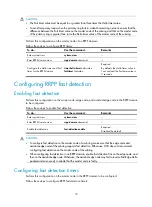
61
•
The master node sends Fast-Hello packets out its primary port at the interval specified by the
Fast-Hello timer. If the secondary port receives the Fast-Hello packets sent by the local master node
before the Fast-Fail timer expires, the entire ring is in the Health state; otherwise, the ring transits into
the Disconnect state.
•
The edge node sends Fast-Edge-Hello packets out its common ports at the interval specified by the
timer resolution. If the assistant-edge node fails to receive the Fast-Edge-Hello packets within three
times the timer resolution, the SRPTs transit to Disconnect state.
As shown in
, with fast detection enabled for RRPP domain 1, Device A, the master node of Ring
1, sends out Fast-Hello packets periodically and determines the ring status according to whether
Fast-Hello packets are received before the Fast-Fail timer expires, implementing link status fast detection.
NOTE:
•
The timer resolution refers to the shortest-period timer provided on an RRPP node.
•
To implement fast detection on an RRPP ring, enable fast detection on the master node, edge node, and
assistant-edge node of the RRPP ring.
Typical RRPP networking
Here are several typical networking applications.
Single ring
shows a single ring in the network topology. You only need to define one RRPP domain.
Figure 14
Schematic diagram for a single-ring network
Tangent rings
shows, a tangent-ring network includes two or more rings in the network topology with only
one common node between rings. You need to define an RRPP domain for each ring.
















































